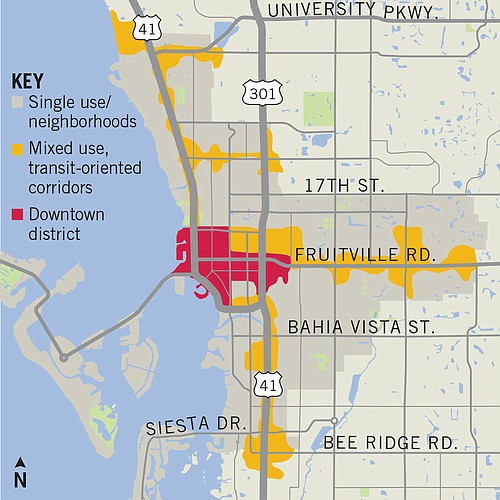- April 25, 2024
-
-
Loading

Loading

As the city works to overhaul a system that measures traffic from new developments, a group of citizens hopes to have their concerns addressed before any changes are made.
The city has introduced the findings of a mobility study over the past year as it prepares to revise elements of the city plan, which came up for consideration at the Sept. 17 meeting of the Planning Board. The goal of these revisions, staff said, was to make the city’s transportation impact fee system more efficient for developers and more effective for residents.
The issue with the current system, the city determined, is twofold. First, traffic studies were required for all projects unless one was particularly small. Many projects did not trigger additional payments after a traffic study was completed, with builders only paying the standard impact fees based on the density or square footage of the development.
The second problem was created after those impact fees were collected. The city was only allowed to make improvements directly to the streets — money was often slotted toward widening the roadway, even if the community indicated a preference for the current state of a street.
The new system, staff said, would address both of these issues. The city plans to create three mobility zones, each with its own acceptable traffic threshold for developments. Below that threshold, developers would just be required to pay the standard impact fees; above it, a traffic study would be required.
Once those impact fees were collected, they could go toward a variety of transportation improvements, including bus stops, bike lanes and traffic-calming measures.
Although the second part of the proposal has been well received, the first part has drawn some scrutiny. A committee of the Coalition of City Neighborhood Associations, led by Laurel Park resident Kate Lowman, has formed to examine the impacts of the new mobility plan on neighborhoods.
One of the leading issues has to do with the mobility zones. The downtown zone — which includes an acceptable threshold of 250 trips during peak hours — includes Laurel Park. Lowman has questioned whether a one-size-fits-all standard within those zones will have a negative effect on some residential areas.
“Does it really make sense to just have three zones?” Lowman said. “How did you decide where those boundaries are? How do you deal with underlying differences within those zones?”
City Engineer Alex DavisShaw said most of the city is already viewed exactly the same when it comes to measuring transportation impacts. The proposed changes would better reflect the city’s land-use plans, she said. Based on a study of the last 10 years of development, the projects beneath the established traffic threshold would likely gain approval either way.
“I wouldn’t say this is making things more general than they are right now,” DavisShaw said.
In addition to questions regarding the specific proposed changes, the CCNA committee has also drawn attention to a bigger question regarding how the city manages its traffic growth.
“Is the new approach coming to terms with the question, ‘Can we handle the capacity placed on our roads?’” Lowman said. “It was not clear to us how this is going to be measured and followed over time.”
DavisShaw said the concern about the city’s traffic capacity was a separate issue. Per state law, she said, developers are just required to address issues caused by the traffic that their project contributes to the streets.
“If the network is already failing, it’s up to the community to make it operational,” DavisShaw said. “I think that’s really part of the problem.”
Regardless of how the city measures traffic for new projects, developers are entitled to build on their property as long as they comply with existing regulations.
“If their traffic is significant, they have to do a study and make improvements,” DavisShaw said. “If the traffic impact is not significant, they still pay — but as long as they’re paying for their impact, you can’t deny them.”
The CCNA committee is finalizing a list of questions and concerns to present at a Dec. 6 meeting, at which point DavisShaw plans to work with the group regarding those issues.
DavisShaw said she believes there’s still several months of discussion coming regarding the mobility plan, and that the details are flexible.
“If things need to be modified a little bit, we can do that,” DavisShaw said. “Hopefully we can work together and get on the same page.”
What’s changing?
The city plans to create three mobility zones.
Each zone has an acceptable traffic threshold.
If new developments exceed threshold, developers must complete traffic study. If they do not, they pay standard impact fees.
Impact fees could go toward transportation improvements other than just streets.